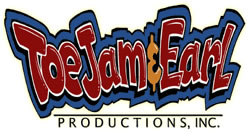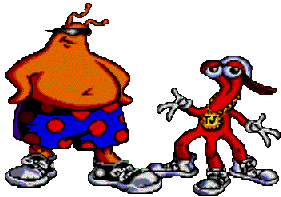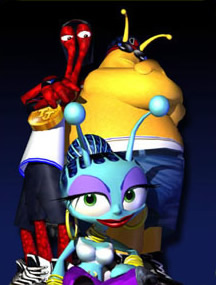In 1991, Sega released a title that was a world apart from the standard platformers and shooting games of the era. ToeJam & Earl took the Genesis by storm with its seamless mix of hip-hop beats, random levels, and simultaneous two-player gameplay. A true Genesis classic, it set a standard for multi-player games that has withstood the test of time.
Say what you will about the character designs (which are entirely appropriate given the context of the game), or the basic gameplay, but you simply cannot ignore the charm and appeal this series has. It will make you laugh out loud, and before you know it, hours have passed and all you’ve done is collect bucks and try out different presents. Yet in spite of all of this, you’ve still had a ball. That is the inherent charm of this franchise, and everything else takes a backseat to this single, guiding concept.
Developer History
 Game designers Mark Voorsanger and Greg Johnson formed TJ&E Productions in 1989. Voorsanger, who had a degree in electrical engineering and computer science, had been in the industry for some time. Early in his career, he programmed for Fathom for the Colecovision and Demon Attack for the Tandy Computer. As a lead programmer for the NEMO project at Hasbro, he was involved with the development of the first full-motion interactive games for in-home use, which eventually became the controversial Sega CD title Night Trap. Voorsanger has also served as a consultant for software development with companies such as LucasArts Entertainment, Activision, and Accolade.
Game designers Mark Voorsanger and Greg Johnson formed TJ&E Productions in 1989. Voorsanger, who had a degree in electrical engineering and computer science, had been in the industry for some time. Early in his career, he programmed for Fathom for the Colecovision and Demon Attack for the Tandy Computer. As a lead programmer for the NEMO project at Hasbro, he was involved with the development of the first full-motion interactive games for in-home use, which eventually became the controversial Sega CD title Night Trap. Voorsanger has also served as a consultant for software development with companies such as LucasArts Entertainment, Activision, and Accolade.
Greg Johnson started in the industry over twenty years ago and has been at the helm of a number of successful titles, like Starflight and Starflight II. Along with his career as a designer, he writes children’s stories and designs board games.
As a team, both Voorsanger and Johnson have released three games in the ToeJam & Earl series, as well as an award-winning children’s CD-ROM titled Orly’s Draw-A-Story for PCs and Macs.
The Games
When Sega went looking for a mascot, they accepted and rejected several submissions. Of all of them, Voorsanger and Johnson’s creation was the closest to being accepted. Though Sega initially considered the game “too American” to be mascot material, but they weren’t blind to the game’s charm and appeal. Billed by the media as the game to own (before a certain blue hedgehog made his debut), ToeJam & Earl was a hit.
Released in 1991, the original ToeJam & Earl initially left gamers scratching their collective heads. What was this? A game from Sega that starred two rapping aliens? It seemed to far-fetched to be true. Yet as they took hold of their control pads and actually began to play, the questions were transformed into laughter, and the addictive gameplay took over.
The most likely reason for its success was its innovative two-player design. Both you and a friend could take the reigns of either alien and funk-a-fy each stage either cooperatively or spit up, and explore on your own. The screen was wisely set up for this, and split horizontally to allow you to see what your pal was doing as you went on your merry way. No other Genesis game (or on any console, for that matter) allowed such freedom for two players at the same time, and TJ&E pulled it off flawlessly.
The story was simple: ToeJam and Earl’s spaceship crash lands on Earth and is blown into several pieces. As they try to recover and repair their ship, the duo is assaulted by several weird and dangerous humans, including the Boogey Man, Insane Dentist, and even Santa himself! Our heroes weren’t totally defenseless though, and had several silly weapons of their own with which to fight off the strange and hostile natives. Presents held goodies such as rocket skates for speed, Icarus wings to fly, and spring shoes for high jumping. Collecting money (bucks) allowed you to send off for more presents or even pay certain characters, like the wizard or opera singer to do you favors (get your mind out of the gutter there, slugger). The wizard healed you, while opera’s favorite fat lady eliminated any baddies on-screen with a multi-octave asault.
As you progressed and collected presents, you earned points that raised your “cool meter.” The boys started out with the undesirable title of Weiner and worked up to Funklord, slowly raising their health bar with each new title. Points were earned by opening presents or by finding terrain tiles (purple tiles covering the map). Should a tile be uncovered with both characters onscreen, both would receive points for the effort.
Humor was the central theme to ToeJam & Earl, and almost everything was geared to make you laugh. For instance, the Boogey Man would cry “boogey! boogey! boogey!” as he approached you, and hordes of tomato-launching chickens roamed the landscape, looking for their next target. Even just leaving ToeJam or Earl idle for a time would have them fall asleep, only to be awaken by a screaming narrator. You could literally play for days and not find all the kooky presents or meet all the weird inhabitants of the game’s massive (for the time) worlds.
Soon after the initial game’s release, both ToeJam and Earl appeared in the 1992 6-in-1 cart that was included along with the Genesis’ flexible new light gun, the Menacer. A short mini game titled Ready, Aim, Tomatoes! allowed the gamer to act as the duo, armed with a tomato blaster that splattered enemies and racked up points. More of a cameo appearance than part of the continuity, it was the one bright spot in an otherwise tepid selection of mini games.
 Things didn’t end there, though. Sega quickly followed up on TE&E‘s success and authorized a sequel. Johnson and Voorsanger quickly began work on a game that was similar in concept to the original but added several new elements, like the ability to enter buildings and caves. Sega executives couldn’t identify with what had made ToeJam & Earl so special and felt that a side scrolling platformer would be more marketable. Rather than have their game shelved, the team decided to scrap their initial build and begin again from scratch.
Things didn’t end there, though. Sega quickly followed up on TE&E‘s success and authorized a sequel. Johnson and Voorsanger quickly began work on a game that was similar in concept to the original but added several new elements, like the ability to enter buildings and caves. Sega executives couldn’t identify with what had made ToeJam & Earl so special and felt that a side scrolling platformer would be more marketable. Rather than have their game shelved, the team decided to scrap their initial build and begin again from scratch.
Panic on Funkotron hit the stores in 1993 to mixed reviews. Gamers still loved the characters and their crazy antics, but struggled to adjust to the new style of play. The humor remained intact, although it didn’t quite mesh with the new dynamic as well as it had with the original. Still, it was a new TJ&E game, and it benefited from better advertising. Sega of America, however, had yet to catch on to its appeal, and merely viewed it as another original title to add to the Genesis line up.
A direct sequel, Panic saw ToeJam and Big Earl finally return home to Funkotron. To their dismay, several Earthlings had stowed away aboard their ship, and proceeded to wreak havoc across the planet. Seventeen stages awaited, as the funky friends tried to clean up the mess they had made. Presents were still the weapon of choice but the new Funkscan helped identify hidden passages, humans, and items. Moreover, you had to capture each human by flinging jars at them. Some required more jars than others, which made a few humans (construction workers, for example), a bit harder to snag. The cast was expanded as well, and we finally got to meet some of the other inhabitants of Funkotron, like the giggling Peabo and the food-loving Bloona. They helped you throughout the game and made the TJ&E universe more solid and convincing.
After Panic on Funkotron, the series disappeared for almost a decade, and both Johnson and Voorsanger moved on to other projects, including ePlanet – a company dedicated to developing new vision-based technology and to creating ground breaking vision-enabled software products. However, in 2002, the duo returned to the franchise and began working on another installment that would eventually appear exclusively on the Xbox. Initially, it was slated for a release on Sega’s Dreamcast but was transferred over when it became clear that the console was not long for this world. The version in progress for that system was coming along nicely, and even had online play for up to three characters (*sigh*, what could have been…). Unfortunately, this feature had to be scrapped when the game changed platforms. As for the change itself, why the Xbox and not the GameCube or more successful PS2? Their website summed it up best:
The simple answer is…we wanted to make TJ&E III the best game it could be. In the end, that meant focusing our energy on one version instead of three. If we had made three versions (and we did consider it), the Xbox version would have been launched already, and we’d be working really hard to create versions of the game for PS2 and the GameCube right now. But here’s the rub…The game would never have come close (on any platform) to what it will be when we launch on Xbox this fall. And the risk of disappointing everyone was just too high.
In ToeJam & Earl III: Mission to Earth, our heroes returned to the planet that had started it all. Alongside Latisha, a sharp-witted character who was playable from the get-go, TJ and Earl were tasked with finding the Twelve Sacred Albums of Funk, which had been stolen from the ruler of Funkotron- Lamont.
Part three went back to the open level layout of the first game but connected everything together to a central hub. This was something Johnson would come to regret later, as he believed it made the random levels less important. Nonetheless, going back to the original concept was a move appreciated by fans and critics alike.
Taking advantage of the incredible power of Xbox, Mission to Earth featured a fully-realized 3D world (complete with changing time of day and moving shadows), Dolby 5.1 digital sound with full voice work, and CG cut scenes to progress the story. Without a doubt though, its best feature had to be its use of Xbox Live. Back in 2002, Live was something everyone liked and no one took advantage of, and TJ&E 3 was one of the first titles to reward gamers with downloadable content. Three new characters and two new levels extended the playtime of an already great title.
 Gameplay was very much reminiscent of the first ToeJam & Earl, and this basically went one of two ways: Either you loved the simple, item-hunting missions, or you thought they were dull and repetitive. Little room was left for any middle ground. This same “take it or leave it” design had been at the center of the TJ&E experience since the beginning, and that game’s classic status (check out those prices on eBay!) pretty much closes the book on whether it works or not. The case may be made that Mission to Earth borrowed a bit too heavily from its source material, but it cannot be denied that the basic grab-and-go gameplay makes it a great game to play in spurts and with a pal.
Gameplay was very much reminiscent of the first ToeJam & Earl, and this basically went one of two ways: Either you loved the simple, item-hunting missions, or you thought they were dull and repetitive. Little room was left for any middle ground. This same “take it or leave it” design had been at the center of the TJ&E experience since the beginning, and that game’s classic status (check out those prices on eBay!) pretty much closes the book on whether it works or not. The case may be made that Mission to Earth borrowed a bit too heavily from its source material, but it cannot be denied that the basic grab-and-go gameplay makes it a great game to play in spurts and with a pal.
Perhaps the only real downside to finally getting a new ToeJam & Earl game was the late hour at which it came. By 2002, some younger gamers, unaware of the series’ roots, dismissed the Xbox entry as dated, but those familiar with the franchise were happy to have Mission to Earth and appreciated the return to the original gameplay style. the inclusion of downloadable content was a welcome bonus.
Bustin’ A Move into the Future?
With the success of the rapping duo’s most recent outing, things look pretty bright for the ToeJam & Earl. Johnson has said that he would like to continue the franchise, though nothing is currently in the works. With the advent of another generation of consoles, and the establishment of the Xbox as a viable brand for the future, I sincerely doubt that things will end at a trilogy. One can only hope so. Be’lee dat!
Want more? Be sure to read our reviews of ToeJam & Earl and Panic on Funkotron, as well as our interview with creator Greg Johnson. Then, gear up for our hands-on of Mission to Earth!
The complete release chronology is as follows:
- ToeJam & Earl, Genesis (1991)
- Ready, Aim, Tomatoes!, Genesis [Menacer 6-in-1 cart] (1992)
- ToeJam & Earl in Panic on Funkotron, Genesis (1993)
- ToeJam & Earl III: Mission to Earth, Xbox (2002)
- ToeJam & Earl, Wii Virtual Console (2006)
- ToeJam & Earl in Panic on Funkotron, Wii Virtual Console (2007)
Sources
- Game info. ToeJam & Earl: Mission to Earth. ToeJam & Earl Productions.
- Pettus, Sam. Genesis: A New Beginning. SegaBase. 2001.
- ToeJam & Earl III: Mission to Earth downloadable content info. Xbox.com.

Pingback: The Definitive History of ToeJam & Earl: A Genesis Deep Dive
Pingback: #6: Games of the early 1990s | Nate Wiesel's History of Games (GAD100 Fall 2015)